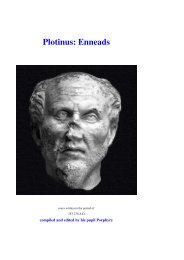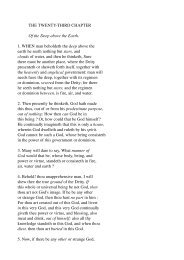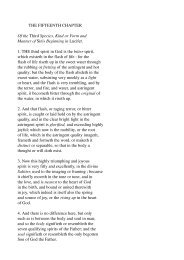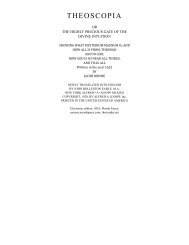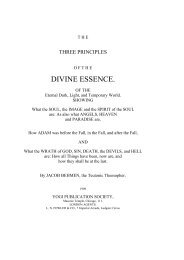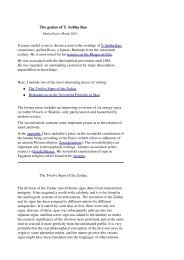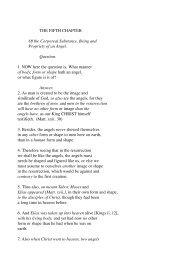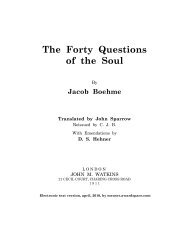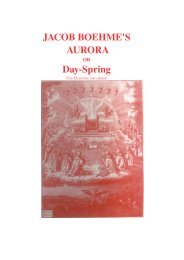Gerald Massey's Lectures - Society in evolution - Awardspace
Gerald Massey's Lectures - Society in evolution - Awardspace
Gerald Massey's Lectures - Society in evolution - Awardspace
Create successful ePaper yourself
Turn your PDF publications into a flip-book with our unique Google optimized e-Paper software.
familiar cat was adopted as a representative, a natural sign, a liv<strong>in</strong>g pictograph of the<br />
lunar orb! Where we should make a comparison, and say the moon saw <strong>in</strong> the dark like a<br />
cat, or the cat saw like the moon by night, they identified the one with the other (a mode<br />
of metaphor which still characterises the great style <strong>in</strong> poetry), and said the cat up there<br />
can see by night. And so it followed that the sun which saw down <strong>in</strong> the under-world at<br />
night, could also be called the cat, as it was, because it also saw <strong>in</strong> the dark. The name of<br />
the cat <strong>in</strong> Egyptian is mau, which denotes the seer, from mau, to see. One writer on<br />
mythology asserts that the Egyptians "imag<strong>in</strong>ed a great cat beh<strong>in</strong>d the sun, which is the<br />
pupil of the cat's eye." But this imag<strong>in</strong><strong>in</strong>g is all modern. It is the Müllerite stock <strong>in</strong> trade!<br />
The moon as cat was the eye of the sun, because it reflected the solar light, and because<br />
the eye gives back the image <strong>in</strong> its mirror. In the form of the Goddess Pasht the cat keeps<br />
watch for the sun, with her paw hold<strong>in</strong>g down and bruis<strong>in</strong>g the head of the serpent of<br />
darkness, called his eternal enemy! The cat was the eye of night <strong>in</strong> the same symbolical<br />
sense that our daisy, which opens and shuts with the ris<strong>in</strong>g and sett<strong>in</strong>g of the sun, is<br />
called the eye of day. Moreover, the cat saw the sun, had it <strong>in</strong> its eye by night, when it<br />
was otherwise unseen by men. We might say the moon mirrored the solar light, because<br />
we have look<strong>in</strong>g glasses. With them the cat's eye was the mirror.<br />
The hare was another type of the eye that opened <strong>in</strong> heaven and saw <strong>in</strong> the dark.<br />
Consequently, we f<strong>in</strong>d the hare <strong>in</strong> the moon is a myth that gave birth to a common and<br />
wide-spread superstition. In later times the symbol is literalized, and it is supposed that<br />
primitive men were always on the look-out for likenesses, like a youthful poet <strong>in</strong> search<br />
of comparisons, and that they saw some resemblance to the form of a hare <strong>in</strong> the dark<br />
shadows of the lunar orb. Whereas <strong>in</strong> mythology th<strong>in</strong>gs are not what they seem to<br />
anybody; that would lead to no consensus of agreement, nor establish any science of<br />
knowledge. A learned man once remarked to me on the strange fact that the ancients<br />
should have selected the least observable of all the planets, Mercury, to make so must of,<br />
as the messenger. He was entirely ignorant of the fact that mythology <strong>in</strong>cludes a system<br />
of time-keep<strong>in</strong>g, and that Mercury was made the planetary messenger (<strong>in</strong> addition to his<br />
lunar character), because his r<strong>evolution</strong> round the sun is performed <strong>in</strong> the shortest space<br />
of planetary time. In like manner, Max Müller will tell you that the moon was called by<br />
the name of Sasnka <strong>in</strong> Sanskrit, from sasa, the hare, because the common people <strong>in</strong> India<br />
th<strong>in</strong>k the black marks <strong>in</strong> the moon look like a hare! But this is mere fool's work or child's<br />
play with the surface appearance of th<strong>in</strong>gs which has little or no relation to true myth or<br />
ancient symbolism; and all such <strong>in</strong>terpretation is entirely mislead<strong>in</strong>g! Egypt, as I contend,<br />
has left us the means of determ<strong>in</strong><strong>in</strong>g the orig<strong>in</strong>al nature and significance of these types.<br />
When the Egyptians would denote an open<strong>in</strong>g, says Hor-Apollo, they del<strong>in</strong>eate a hare,<br />
because this animal always has its eyes open. The name of the hare <strong>in</strong> Egyptian is Un,<br />
which signifies open, to open, the opener, especially connected with periodicity, as the<br />
word also means the hour. This will expla<strong>in</strong> how the wide, open-eyed hare became a type<br />
of the moon, which opens with its new light once a month, as the hare <strong>in</strong> heaven. The<br />
hare is the hieroglyphic sign of the opener, which can be variously applied to the<br />
phenomena of open<strong>in</strong>g; to the sun as well as the moon. The hare is an especial emblem of<br />
the god Osiris <strong>in</strong> the character of Un-Nefer, the good opener; <strong>in</strong> later phrase, the good<br />
revealer! It is as the seer that both hare and cat are associated with the witch as types of<br />
abnormal seership. The hare also denoted the open<strong>in</strong>g time, as the period of pubescence,<br />
when it was lawful for the sexes to come together. Hence it was the type of periodicity<br />
and legality <strong>in</strong> the human phase! For this reason, the youths among the Namaqua<br />
Hottentots are (or were) not allowed to eat the hare. With the Ch<strong>in</strong>ese the rabbit takes the<br />
place of the hare as a lunar type. Its period of gestation be<strong>in</strong>g thirty days, that would<br />
make it an appropriate representative of the lunation, of open<strong>in</strong>g anew, and of re-birth.<br />
The Selish Indians have a myth of the frog <strong>in</strong> the moon. They tell how the wolf, <strong>in</strong> love<br />
with the frog, was pursu<strong>in</strong>g her by night, when she leaped <strong>in</strong>to the moon, and escaped.



